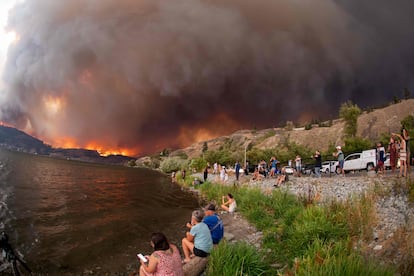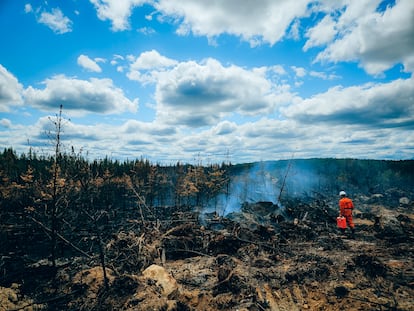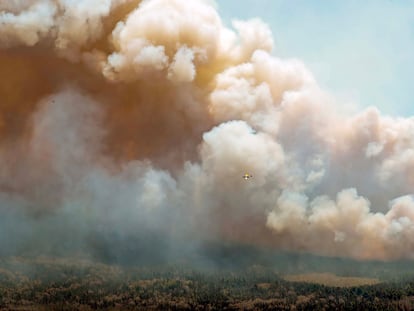Canada’s blazing inferno: 2023 wildfires swept through an area larger than Florida
This year, Canadians suffered the worst wildfire season on record. Meanwhile, Justin Trudeau’s government is seeking to tackle climate change through a strategy that has attracted some criticism


The 2023 wildfire season in Canada was the worst on record. According to the Canadian Interagency Forest Fire Centre, the flames of 6,669 fires destroyed 18.5 million hectares, an area larger than Florida. However, the authority stopped submitting daily reports on September 27, meaning that the area devastated is larger, as the flames continued to devastate certain areas for weeks afterward. The EU’s Copernicus Program has calculated that these fires emitted at least 410 million tons of CO₂, much more than all the emissions recorded in Spain in 2022 (244.3).
Alarm bells began ringing towards the end of April and beginning of May, when the province of Alberta recorded an unusually high number of wildfires in a short period. British Columbia, the neighboring province on the Pacific coast, was next to be the cause for concern. The Northwest Territories of Quebec and Nova Scotia were also affected by wildfires. More than 200,000 people had to be evacuated because of the flames and smoke.

Philippe Gachon, professor of climatology at the University of Quebec in Montreal, is one of the international experts who recently published a study on this year’s wildfires in the province of Quebec. The main conclusion he reached was that climate change has doubled the risk of weather conditions favorable to these fires. “Between May and October, we broke the record for the hottest months for that season in Quebec. The previous record was set in 1950. We also broke the record for the least accumulated precipitation for those six months,” says Gachon. “The snow thawed very quickly. This led to unusually early fires.”
It was not only the number of fires that sparked concern, but also the extent of some of them. Flames in an area on the borders of British Columbia and the Northwest Territories burned some 802,000 hectares. In northern Quebec, near James Bay, another fire engulfed more than 1.2 million hectares. “If we consider the combination of drought and heat, the material that lies under the snow in the winter becomes very flammable. What we witnessed was an extremely rapid and powerful advance of the flames,” explains Gachon.

Despite the support of the Canadian army, the government’s response was outpaced by the intensity of the fires, meaning that thousands of firefighters from various countries (the U.S., France, Spain, Mexico, Brazil, among others) came to assist. The losses have amounted to millions of dollars for certain sectors of the Canadian economy. Such is the case of the forestry, agriculture, mining and tourism industries. A report by Oxford Economics at the end of June estimated that the fires could reduce Canadian economic growth in 2023 by between 0.3 and 0.6 percentage points. Nevertheless, the damage has also affected areas outside the country. One example of this is the impact on corn crops in Ohio and Indiana. The smoke and particulates from the Canadian fires caused apocalyptic landscapes in New York and Washington, even reaching the Iberian Peninsula.

According to a report by the Institute of Applied Ecology of the Chinese Academy of Sciences published on July 28, the fires in Canada had released 302 megatons of carbon. On September 10, the European Union’s Copernicus Atmosphere Monitoring Service estimated nearly 410 megatons. The previous record for Canadian flames came in 2014, with 138 megatons. This is much more than all the greenhouse gas emissions — which includes transport, industry, livestock and other sectors — recorded in Spain for an entire year: in 2022, the country released 244.3 megatons, according to the latest National Emissions Inventory.
Canada had already made headlines in the summer of 2021 for the phenomenon known as “heat dome.” Lytton, a community located in British Columbia, constituted the most extreme case, with temperatures reaching 49.6 °C, or 121.28 °F. At the end of 2022, before the unprecedented wave of forest fires, the parliamentary budget director presented a report stating that Canada was already feeling the consequences of climate change. According to the document, these consequences resulted in a 0.8% decrease in GDP in 2021, and this could rise to 2.4% in 2050.
Climate change: challenges of the Canadian blueprint
Justin Trudeau’s government has implemented a strategy to tackle climate change and its impacts. This strategy includes, among other things, a national program for adaptation to extreme weather conditions, financial support for developing countries to deal with these threats, an increase in the number of protected areas, a carbon pricing plan and investments in “green” energies. All this will be accompanied by an ambitious plan to reduce greenhouse gas emissions.
Meanwhile, Canada’s Minister of Environment and Climate Change Steven Guilbeault announced on Thursday a new framework for limiting greenhouse gas emissions from the oil and gas sector that is expected to come into force in 2026. The plan involves fixed figures, including setting emissions by 2030 at a maximum of 38% below 2019 levels. However, companies will be given some flexibility in meeting the targets, as they will be able to contribute to a decarbonization fund or pay offset credits. The sector is responsible for 28% of Canada’s emissions.
Several environmental groups welcomed the news, but expressed regret that Ottawa continues to focus on emissions reductions instead of production reductions. The governments of Alberta and Saskatchewan claimed that the plan will have serious economic repercussions, as well as violating provincial jurisdiction. For its part, the Canadian Association of Petroleum Producers said in a statement that adding regulations could hamper its investments in clean energy projects.
On November 8, a U.N. report argued that oil-producing countries plan to produce more than twice the fuel required to limit global warming to 1.5 °C by 2030. Canada is the world’s fourth-largest producer, and it is estimated that in 2035, Canadian fossil fuel production will be 25% higher than the level recorded in 2022.
Canada’s strategy is more concerned with reducing emissions from oil and gas companies than with significantly eliminating production in the sector. This is illustrated by investments and fiscal incentives related to carbon capture and storage in Alberta, the nation’s main oil-producing province. However, the International Energy Agency recently pointed out that “the amount of electricity needed to energize these technologies would exceed current global electricity demand.” It also said that oil and gas companies should pursue a more vigorous diversification process into clean energy rather than putting so much emphasis on carbon capture and storage.
“It is often said that the Trudeau administration is too lenient on the fossil fuel industry. Certainly more could be done, but it is a complex situation because of Canadian federalism,” says Simon Langlois-Bertrand, a researcher at the Trottier Energy Institute at Polytechnique Montréal. “We must conduct consultations, meet with the provinces; all of this very prudently. According to constitutional guidelines, the federal government cannot control production, but it can control emissions. We should remember that even Trudeau’s carbon pricing plan went to the Supreme Court,” he adds.
This Monday, in the context of COP28 in Dubai, Minister Guilbeault announced that his country will intensify its monitoring of methane emissions in the fossil fuel infrastructure system. This measure will primarily serve to detect leaks and eliminate the regular flaring of such gas. Guilbeault pointed out that both the strategy implemented by Canada and other decisions in the future will help to achieve the goal of a net-zero emissions balance by 2050.
“The Trudeau government has pushed several agenda items forward. However, they have been successful on issues that are not as complex. For example, removing coal from electricity production and boosting clean technologies. But now we are at a stage where difficult decisions must be made in order to accomplish our goals. It is a defining moment. The next step is the announcement of the emissions cap for the Canadian oil and gas sector,” says Simon Langlois-Bertrand.
Sign up for our weekly newsletter to get more English-language news coverage from EL PAÍS USA Edition
Tu suscripción se está usando en otro dispositivo
¿Quieres añadir otro usuario a tu suscripción?
Si continúas leyendo en este dispositivo, no se podrá leer en el otro.
FlechaTu suscripción se está usando en otro dispositivo y solo puedes acceder a EL PAÍS desde un dispositivo a la vez.
Si quieres compartir tu cuenta, cambia tu suscripción a la modalidad Premium, así podrás añadir otro usuario. Cada uno accederá con su propia cuenta de email, lo que os permitirá personalizar vuestra experiencia en EL PAÍS.
¿Tienes una suscripción de empresa? Accede aquí para contratar más cuentas.
En el caso de no saber quién está usando tu cuenta, te recomendamos cambiar tu contraseña aquí.
Si decides continuar compartiendo tu cuenta, este mensaje se mostrará en tu dispositivo y en el de la otra persona que está usando tu cuenta de forma indefinida, afectando a tu experiencia de lectura. Puedes consultar aquí los términos y condiciones de la suscripción digital.
More information
Archived In
Últimas noticias
There is as much life left to discover on planet Earth as that which is already known
Dozens presumed dead, around 100 injured in fire at Swiss Alps bar during New Year’s celebration
Is porn for women different from conventional porn? We spoke to those who make it
Cartagena de Indias is sinking: What can the city do to mitigate it?
Most viewed
- Sinaloa Cartel war is taking its toll on Los Chapitos
- Reinhard Genzel, Nobel laureate in physics: ‘One-minute videos will never give you the truth’
- Oona Chaplin: ‘I told James Cameron that I was living in a treehouse and starting a permaculture project with a friend’
- David King, chemist: ‘There are scientists studying how to cool the planet; nobody should stop these experiments from happening’
- Why the price of coffee has skyrocketed: from Brazilian plantations to specialty coffee houses










































